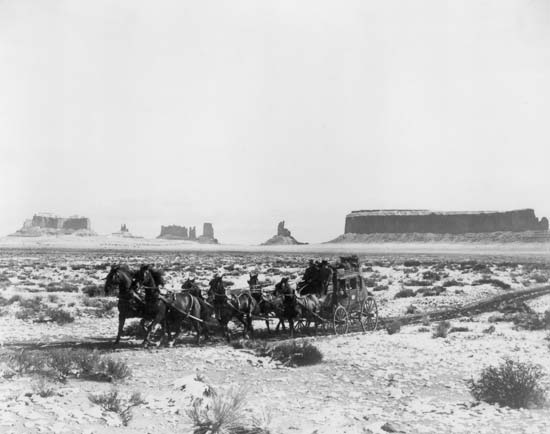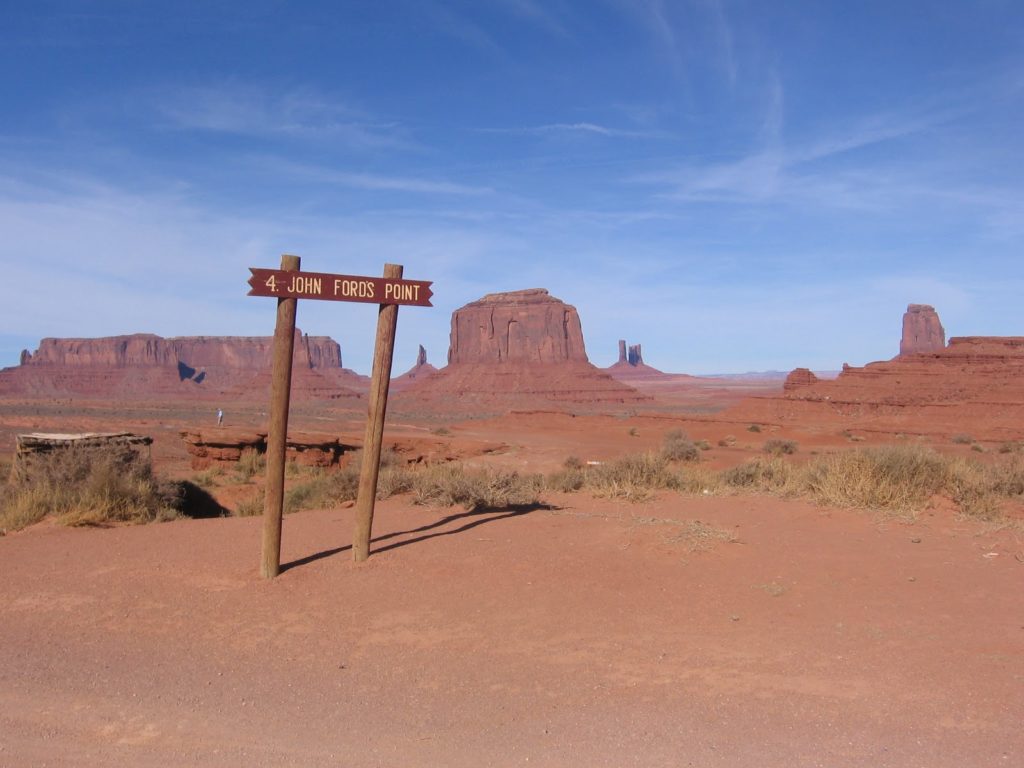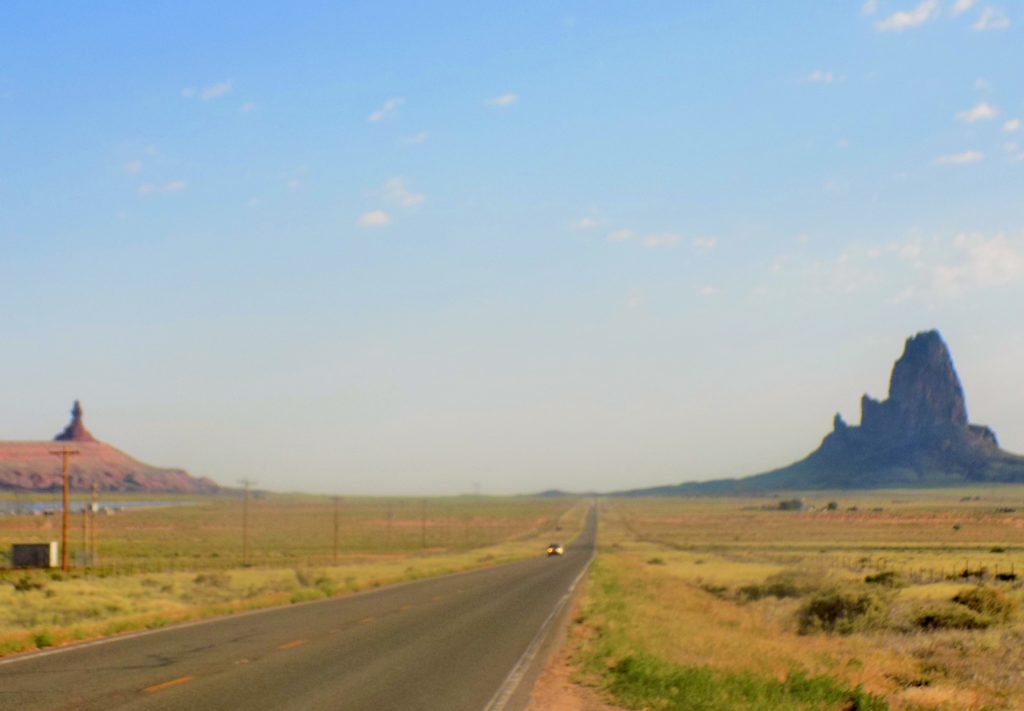I’ll be driving a lot and sightseeing a little today. And, of course, that means a certain amount of backtracking even if it’s only 24 miles. Fortunately, the two places I’m visiting – one in Arizona and one in Utah – may be the most spectacular on the trip thus far.
Shaping our view of the American west.
My first stop today is Monument Valley and the header for this section is a reference to John Ford. If you visit Monument Valley today, whether you attempt to navigate the unpaved road on your own or opt to take a guided tour, John Ford Point will be one of the places you stop:
Here’s a bit of the back story.
In 1925 a Coloradan named Harry Goulding moved to the valley and opened a small trading post where, according to the few sources I tracked down, he worked cooperatively and had generally cordial relations with the Navajo who lived there. As happened to many, the Great Depression hit Goulding (and the Navajo) hard. A local drought and problems created by overgrazing compounded everyone’s struggles. Sometime in the late 1930’s Goulding heard a radio story that someone in Hollywood was looking for a location to shoot a western. One day, he looked out his window and had his eureka moment.
Sensing an opportunity to turn things around for both his trading post and his Navajo neighbors, Goulding gathered up his photographs of the landscape outside the door, tossed a bedroll and some camping gear in his truck, and headed off to Los Angeles sometime in 1938. He somehow managed to find an entry into the offices of United Artists and to show the photos to a 43-year-old director named John Ford. By the time Goulding and his wife Leone (whom everyone called Mike) left LA, they had a check in hand for $5,000 and a contract to accommodate a cast and crew while they filmed in Monument Valley.
When filming finally began, Navajos were hired as extras (albeit to play Apaches) and Ford, wanting to ensure he had “fluffy cinematic clouds” reportedly hired a local shaman to control the weather.
The film that Ford made was nominated for seven Academy Awards including Best Director and Best Picture and launched a former stuntman cinematically named John Wayne to stardom. Unfortunately for Ford, he released his classic western Stagecoach in 1939. His competition for the Best Picture Oscar included The Wizard of Oz, Mister Smith Goes to Washington, Goodbye Mister Chips, Of Mice and Men, Wuthering Heights, Ninotchka and, of course the winner, Gone With the Wind. Stagecoach was the first of seven movies Ford would shoot in Monument Valley and the success of Stagecoach and iconic images like this one
shaped the way Americans view the west even to this day. If you’re interested, you can find a list of Monument Valley’s media appearances on Wikipedia. I can’t assure you that it’s complete and comprehensive but it is a long one.
However, I didn’t come to Monument Valley simply for its use in so many movies. No, to be this close to a landscape like this starkly beautiful corner of the Navajo Nation that straddles Arizona and Utah and not see it would be all but unthinkable. (The park entrance is in Utah but most of what I saw is in Arizona.)
A bit of a Dutch treat.
That I’d started the day early prompted some moments of serendipity. While not particularly serendipitous, soon after leaving Kayenta, I passed this peak that,
in its isolation, looked very much like the one I’d seen approaching Kayenta. It did, however, remind me to do a little post facto research. I learned that the one in the photo above is commonly called El Capitan but the Navajo call it Aghaałą́ and consider it a sacred site. (Had I known this at the time, I’d have at least made a better photographic effort.)
This formation is very different from those I would see in Monument Valley and very much like the one I saw on my trip into Kayenta yesterday which I learned is called Church Rock. These formations are preserved volcanic plugs. A volcanic plug forms when magma hardens within a vent on an active volcano. If the volcano beneath it becomes inactive, the plug can be preserved and, because it resists erosion, it produces a distinctive upstanding landform. Now we know.
Monument Valley is a Navajo Tribal Park and not part of the U S National Park system. (I’ll explain how that occurred later.) I paid my $20 entrance fee and, having survived the stones and dips of the unpaved road through Organ Pipe Cactus National Monument, I planned about two hours to drive the 17-mile loop through Monument Valley.
Very early on, I encountered a steep, rutted, rocky hill and thought that if it was representative of the rest of the road, my little Hyundai Accent was going to struggle. So, I turned around and headed back to the parking lot at the Visitor’s Center to see if I could arrange a tour. (The tours have access to parts of the park that are publicly restricted and, as you’ll see in my photos, this turned out to be a happy choice.)
I hesitated to pay the price for a solo tour which was essentially the cost of a tour for two people and, when I displayed a disinclination to wait for a group to arrive, one of the guides offered to tote me down in his jeep and connect me with a tour that had begun shortly before. That seemed ideal.
When I arrived, there were two people – Luke and Anna – plus Albert the guide. Though they didn’t seem the least put out at having had to wait for me, I apologized and thanked them for their patience. Well, it turns out that Luke and Anna are from The Hague. Sadly, while we exchanged bits of conversation during our three-hour journey, they weren’t particularly talkative. I think Luke’s English was a bit better than Anna’s but both seemed reasonably comfortable speaking my native tongue. They were making a grand tour of the American West and planned to visit as many of these very un-Dutch like places as they could.
Even though they weren’t overly chatty, one benefit of getting on an early morning tour is that we were only three. As we completed the circle of our ride, we passed vehicles like ours that were packed with 15-20 passengers. I have to believe we got much more attention from Albert than they would from their guides.
Another brief lesson in geology.
Although it’s not a canyon, Monument Valley or Tse Bii’ Ndzisgaii (meaning Valley of the Rocks) as the Diné call it, was shaped by the same forces of uplift and erosion that shaped the area’s canyons. Prominent mesas and buttes in an area are generally reliable evidence of uplift and extensive erosion through weathering.
But Monument Valley is so different because other factors contribute to creating its look. Unlike the gradual erosion such as that carved by river flow, rushes of water from monsoon like downpours in generally arid areas like Tse Bii’ Ndzisgaii can cause more sudden and rapid erosion than the steadier erosion from rivers. Wind also played an important role in shaping this particular land in a process called aeolian or wind erosion.
Wind erosion commonly occurs in flat, bare areas or anywhere the soil is loose, dry, and finely granulated. The wind removes soil from one place and deposits it in another. It causes soil loss, dryness, and deterioration of soil structure. Over millions of years, this wind-borne process of moving dust and dirt from one place to another is one geologists call sediment transport and deposition. This creates aeolian erosion. This process plays a significant factor in the geological changes that occur on the land around us and over long periods of time and shape places like Monument Valley. This three-and-a-half-minute video provides a clear and concise explanation.
But there’s one additional factor critical in making Monument Valley look the way it does. This area has a particularly thick layer of caprock in comparison to the size of its landform features. (Depending on their makeup, rocks erode at different paces. Think of the lava plugs I discussed above.) Much as it sounds it would be, caprock is a harder or more resistant rock type overlying (or capping) a weaker or less resistant rock type.
Now that I’ve told you how Monument Valley came to be, we can start our ride through it. And that happens in the next post.

